MG4205 Individual Project Report Assignment Sample
Here’s the best sample of MG4205 Individual Project Report Assignment, written by expert.
Introduction
This assignment deals with the critical evaluation and identification of the factors that lead to the failure of “Wembley Stadium Project” and success of “NHS Luisa Jordan Project”. The assignment would highlight on how project managers utilize the tools such as “Product breakdown structure”, “Work breakdown structure”, “Gantt chart”, ”scheduling process” and “network diagram” for planning, monitoring, and managing the delivery and scope of the project.
Overview on projects
Wembley Stadium Project
The project of refurbishing the old Wembley Stadium to new one by an Australian construction involves larger amount of issue and risks which ceases its success of completion (Project Management Ireland, 2021). Risk which are coming across by: – missing of clarity about project aims and objective, communication gap, arising of delay in project is high, cost are overrunning, technological risks becoming very high, objections from the local authorities is increasing, environmental risks becoming fearful, knowledge gap of the team occurring, ideas are clashing by different parties, stakeholder involvement is high, opposition of local authority is high etc. The project is facing discrepancies between short and long term goals.
The strategies which are taken:- following a project plan with a timeline, conducting daily meeting like chat tool, and mobile communications app, involving cost consultant during making plan and design, make clarity about the aim and objectives of project with specific requirements. This project ended in €789 million.
NHS Louis Jordan Project
NHS Louis Jordan project was made to meet an emergency with the pandemic Covid 19 in Scotland. It is located in Glasgow Sec centre. Although, this project excelled in providing facilities and great care to Covid patient delivered in three weeks, this turn out to the bad circumstances.
This project faced opposition of local authority, discrepancies between short and long term goals, communication gap which are done by project sponsor, advisory group, project manager, objection received by NHS staff, shortage of skilled nurse found, time and cost was overrunning.
The strategies which were made to tackle the situation are:- make availability of detailed scenario of existing healthcare, infrastructure, etc.
The project new strategy is to extend the capacity from 300 bed to 1000 so that majority of patient be cured (Gov.scot, 2021). The 10 stakeholders involved in this project contributed in many ways. Their involvement is necessary as they meet the discussion, share all the information and execute them well.
Critically evaluate and identify factors that lead to the failure of “Wembley Stadium Project”
The Wembley Stadium is the property of the “English Football Association” and is managed by the subsidiary of “Wembley National Stadium Limited’. This project is of high budget and hence there are several delays for various reasons. In the year 2000 in the month of September, Multiplex “Australian Construction Company” signed the contract of demolishing the “Wembley Stadium” and decided of building a new stadium. The budget of the contract was 326.5 billion pounds. Unfortunately there was delay in this project (Akhmetshinet al. 2019). In the year 2001, in the month of May the football association were the owners of the Wembley Stadium admitted that the project was doomed as there was no bailout of the government. The football association took another year for securing funding to continue the project. A loan agreement was signed with German Bank, WestLB and then started demolishing of the old stadium. The official demolition of the Wembley Stadium started in the year 2002 in the month of September.The act of demolishing started in the year 2002. In December the twin towers were demolished. The twin towers were demolished for making a new capacity of 90000. The reasons for the demolishing of “Wembley Stadium” were that it was in the middle of the new stadium and had no utility or practical purposes. The cost involved in the building of Wembley Stadium cost 798 million pounds. The stadium does not have any retractable roof covering the surface for playing (Portny, 2017).
In Wembley Stadium Arsenal haveplayed 46 matches and in the year 2003, the construction began and appeared things to run smoothly. However, there were many issues that delayed the project and the cost thus increased. The factors that delayed the project were as follows:
- The subcontractor underestimated the project scope
- The subcontractor went out of the project
- There was another subcontractor who violated the safety and the health laws of the project
These issues led to the delaying of the project. The project was scheduled to be completed in the year 2006. The “Football Association” booked football matches and events in the stadium. Then those matches and events were supposed to be relocated and rescheduled as the construction of Wembley Stadium was not completed. Cleveland Bridge walked from the Wembley Stadium project in the year 2004, August. Cleveland Bridge warned the Multiplex about the increase in cost of the construction of the arch. The multiplex faced issues and there were delays in the construction of arch and a big accident occurred. On the site of the accident, O’Sullivan was killed (Dovgan, Mokhonko and Artemenko, 2017).
Wembley Stadium Project failed because of the improper use of the project management skills lead to the failure of the project. Moreover, project management becomes effective when people use it properly. Time is an important element of any project. Any delays can lead to rise in the cost of the project which happened in Wembley Stadium. Budget is also an important element of project management. For Wembley Stadium project there was a requirement for high budget and hence forecasting is important and along with that calculation of the cost of the project is also a vital parameter.
The Wembley Stadium was planned to start in the year 2000 and finish by theyear 2003. Financial problems and disagreements with the stakeholders delayed the starting of the project to September 2002. The opening that was announced in the year 2006 was also delayed. Hence, many people feared that the stadium was not ready and there was rising of several problems related with the Multiplex. The project finally completed on 2007 which is four years after the actual opening of the stadium. This wrong calculation of the timings several events got cancelled and also led to increase in the cost of the project (Dovgan, Mokhonko and Artemenko, 2017).
This project failed due to the time and budget mismanagement and the scope of the project was not clear to the builders as there was poor management of the project. Despite the fact that Wembley Stadium is still one of the best stadium of the world as the project succeeded in the terms of quality and product achievement. The principles of project management PRINCE 2 have worked together in making the stadium as one of the biggest stadium. These seven principles are:
- Business justification
- Defined responsibilities a nd roles
- Managed through exception
- Tailoring to the needs of the project environment
- Learning from experience
- Managing by the stages
- Focusing products
Critically evaluate and identify factors that lead to the success of “NHS Luisa Jordan Project”
NHS Louisa Jordan was an emergency critical temporary unit that was constructed for dealing with the pandemic Covid 19 in the country of Scotland. It was located in Glasgow Sec centre. It was operated by the NHS Scotland. Initially it planned to have 300 beds in the critical care unit. This project was born out of the bad circumstances. However, the construction of this project was the best. In the cost management and in the project management there is working of the multi-disciplinary. The facility was delivered in three weeks and the team was pulled together and the members of the team worked for long hours and undertook technical efforts for coordination of the activities and achieving of minor miracles (Nicholas and Steyn, 2017).
This project focused on engagement and collaboration of principles. The absence of commercial hindrances focused of motivating the success of the project and drove success of the project in every aspects. This project helped in speeding the making of the decision and lead to willingness for taking of the risk and also leads to the implementation of the safety and health measures. The main element of NHS Louisa Jordan project was digital transformation and design transparency. Project was regularly met with various kinds of work reviews. It leads to the building of milestones for the completion of the project (Al-Hajj and Zraunig, 2018). As, the project emerged or evolved out of emergencies hence, there was no lethargy in the completion of the project. The project was completed timely as there was a rush for building of critical care unit for the Covid 19 patients. The project work was reviewed constantly and the project was able to achieve the milestones at proper time. There was increase in the quality of assurance and have upfront cost. It could have saved significant money and time in the construction of the time. The design priority of the project was the speed at which the project was delivered. There was standardization of elements and repeatable design in the patient beds and in accommodation facilities (Kerzner, 2018). The “repeatable design” sped up the process of procurement. The immediate benefits of the project was maintaining of social distancing on the sites of construction. Hence, the project manger implemented the skills of project management which lead to the successful and timely completion of the project of NHS Louisa Jordan. NHS Louisa Jordan project used digital tools for recording the defects in the projects. The dynamic tools that were embedded in the project were BIM360 for monitoring and recording of the defects in the project in real time. It used the “BIM Field ipad system for the raising and closing of the defects that worked brilliantly. The defects in the project were identified quickly at the right time. The project manager can save hours of time and maintaining the quality of the project all through. It leads the project manager in providing a transparent and dynamic assurance to the subcontractors and contractors for maintaining of their own quality. The project manager built better flexibility n d repurposing of the designs. NHS Louisa Jordan project has more “hybrid spaces” which provided scope for repurposing and greater flexibility. NHS Louisa Jordan project was successful as there was effective implementation of project management practices and the project was completed on time and hence there was no rising of costs (Abyad, 2018).
Analyzing the tools that are used by project managers for planning, monitoring and managing the delivery and scope of the project
- a) Product breakdown structure – Product breakdown structure is a tool for documenting, analyzing, and communicating the project outcomes and is a part of the technique of product based planning. This Product breakdown structure refers to “an exhaustive, hierarchical tree structure of deliverables that makes up the project, arranged in whole-part relationship”. This Product breakdown structure precedes the Work break down structure that focuses on achieving desired outcomes of the project. Product breakdown structure is used in the running of the project. It is used as a useful tool for tracking of the management. It also serves as a process for quality assurance. It refers to the individual product that helps in driving the success of the project. This structure helps in measuring the progress of the project (Levy, 2018).
- b) Work breakdown structure– it forms as the basis of the delivery of the planned project and is used for allocating task to individuals and teams and holding them accountable for the progress. Work breakdown structure serves as a bridge between the required outcomes and the delivering organization of the project. It helps in the organizing and defining of the task required. It leads to the quicker development of the schedule by allocating the effort estimates in the specific areas of work breakdown structure. Work breakdown structure helps in estimating costs, scheduling, and in the determination of risk. It helps in the elimination of necessary work that is done for achieving the required results. The deliverable of work breakdown structure can be an object, activity or service. It is a simple and methodical way of organizing the scope of the project into manageable and smaller components (Frefer et al. 2018).
New Wembley Stadium
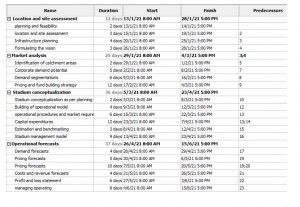
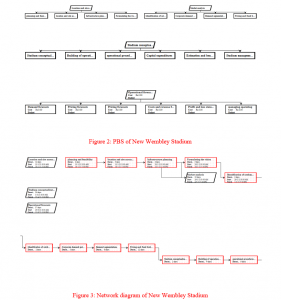
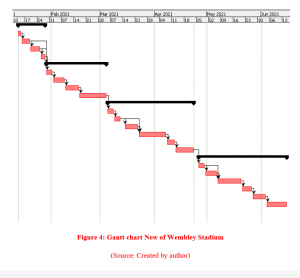
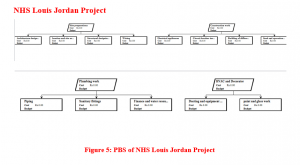
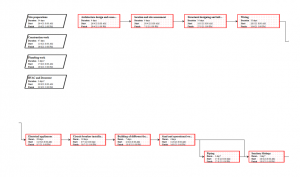
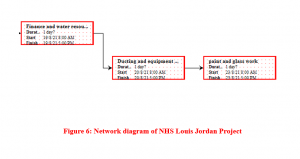
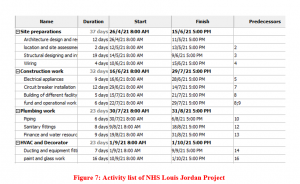
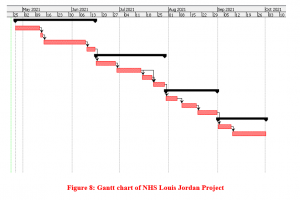
- c) Gantt chart and scheduling process – Gantt chart helps in scheduling and planning of the project. It helps in assessing the length of the project and also determines the resources that are required in the project. This Gantt chart helps in planning the order of the completed tasks. Moreover, it is helpful in managing the amount of dependencies in the task. Gantt chart provides an overview of the project. It helps in handling of the scheduling and planning of the team. This chart helps in making it easier to work together and to set the efforts and the woks of the team in achieving the desired outcome. This chart helps in drilling down of the activities that are required to b e done in a fixed time. It is used for tracking of the schedules of the project (Kerzner, 2017).
Scheduling process in project management is helpful as it ensures that everyone is in the same page with the deadlines, tasks and dependencies. It helps in highlighting the concerns and the issues. The issues include lack of resources and it identifies the task relationships and is helpful in monitoring progress and identifying the issues quickly. Scheduling is very important for ensuring the success of the project. It helps in keeping track of the project, maintaining time frames, assigning of the resources and managing of the quality for decreasing the errors in the project. It thus results in reduction in the cost of the project and increasing in the satisfaction of the customers (Meredith, Shafer and Mantel, 2017).
- d) Network diagram – network diagram is a useful tool in the hands of project managers as it helps them in visualizing the activities that are required to be finished within the specified duration of time. It also provides details regarding the task dependency, sequence and duration. Network diagrams are helpful in controlling, organizing and planning the activities of the project. The activities in a project maintain a sequence of interrelationships (Singh and Williams, 2021). The network diagram helps the project managers and their teams in organizing and planning of the activities. At the time of project execution, network diagrams help in getting a glimpse of the activities of the project. Moreover, this network diagram help in the displaying the workflow of the activities of the project. It helps the manager in understanding the sequence of the activities.
Conclusion
From this study, it has been understood that success of a project requires collaboration among the project participants. In the case of Wembly Stadium project analysis, it is clearly observed that the there was lack of collaboration among the project team and the sub-contractors. At the same time, the budget was also ineffective for this project; whereas, the NHS project was successful due to the systematic approach and extreme collaboration among the project parties.
References
Abyad, A., 2018. Project management, motivation theories and process management. Middle East Journal of Business, 13(4), pp.18-22.
Akhmetshin, E.M., Romanov, P.Y., Zakieva, R.R., Zhminko, A.E., Aleshko, R.A. and Makarov, A.L., 2019. Modern approaches to innovative project management in entrepreneurship education: A review of methods and applications in education. Journal of Entrepreneurship Education, 22, pp.1-15.
Al-Hajj, A. and Zraunig, M., 2018. The impact of project management implementation on the successful completion of projects in construction. International Journal of Innovation, Management and Technology, 9(1), pp.21-27.
Dovgan, L.E., Mokhonko, A.А. and Artemenko, L.P., 2017. Project management.
Frefer, A.A., Mahmoud, M., Haleema, H. and Almamlook, R., 2018. Overview success criteria and critical success factors in project management. Industrial engineering & management, 7(1), pp.1-6.
Gov.scot. 2021. Construction of NHS Louisa Jordan complete – gov.scot. [online] Available at: <https://www.gov.scot/news/construction-of-nhs-louisa-jordan-complete/> [Accessed 21 April 2021].
Kerzner, H., 2017. Project management: a systems approach to planning, scheduling, and controlling. John Wiley & Sons.
Kerzner, H., 2018. Project management best practices: Achieving global excellence. John Wiley & Sons.
Levy, S.M., 2018. Project management in construction. McGraw-Hill Education.
Meredith, J.R., Shafer, S.M. and Mantel Jr, S.J., 2017. Project management: a strategic managerial approach. John Wiley & Sons.
Nicholas, J.M. and Steyn, H., 2017. Project management for engineering, business and technology. Taylor & Francis.
Portny, S.E., 2017. Project management for dummies. John Wiley & Sons.
Project Management Ireland. 2021. Wembley Stadium – A Badly Run Project with a Good Outcome!. [online] Available at: <http://www.projectmanagement.ie/blog/wembley-stadium-a-badly-run-project-with-a-good-outcome#:~:text=Wembley%20Stadium%20%E2%80%93%20A%20Badly%20Run%20Project%20with%20a%20Good%20Outcome!,-Every%20football%20fan&text=The%20construction%20of%20Wembley%20Stadium,thanks%20to%20its%20signature%20arch.> [Accessed 21 April 2021].
Singh, H. and Williams, P.S., 2021. A Guide to the Project Management Body of Knowledge: PMBOK (®) Guide. Project Management Institute.
Appendices
Work breakdown structure
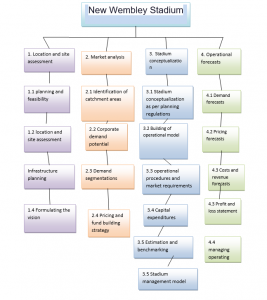
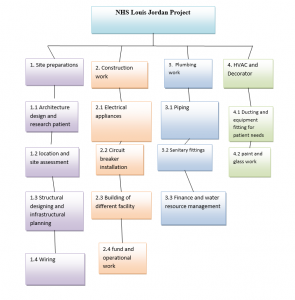
________________________________________________________________________________
Know more about UniqueSubmission’s other writing services:

